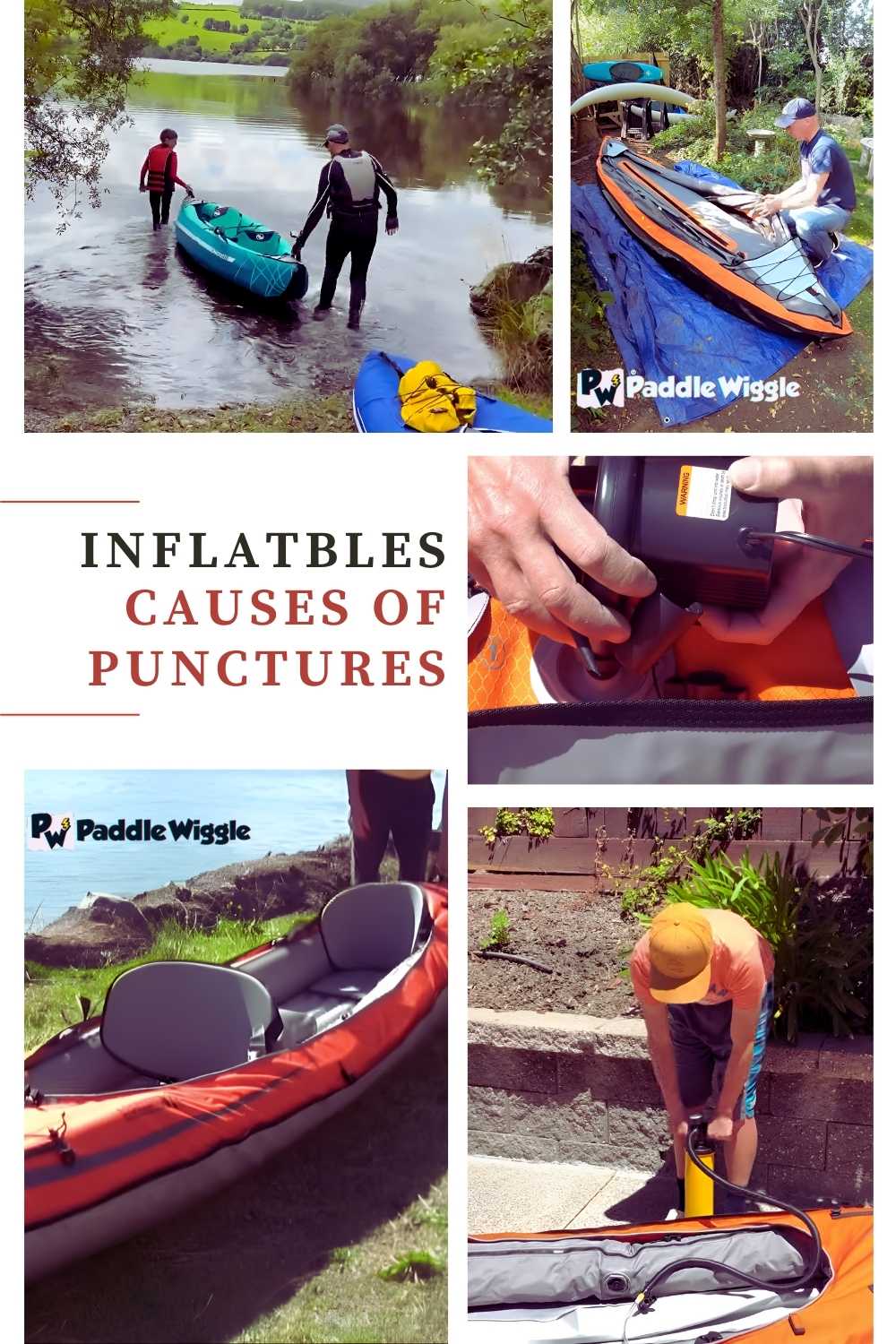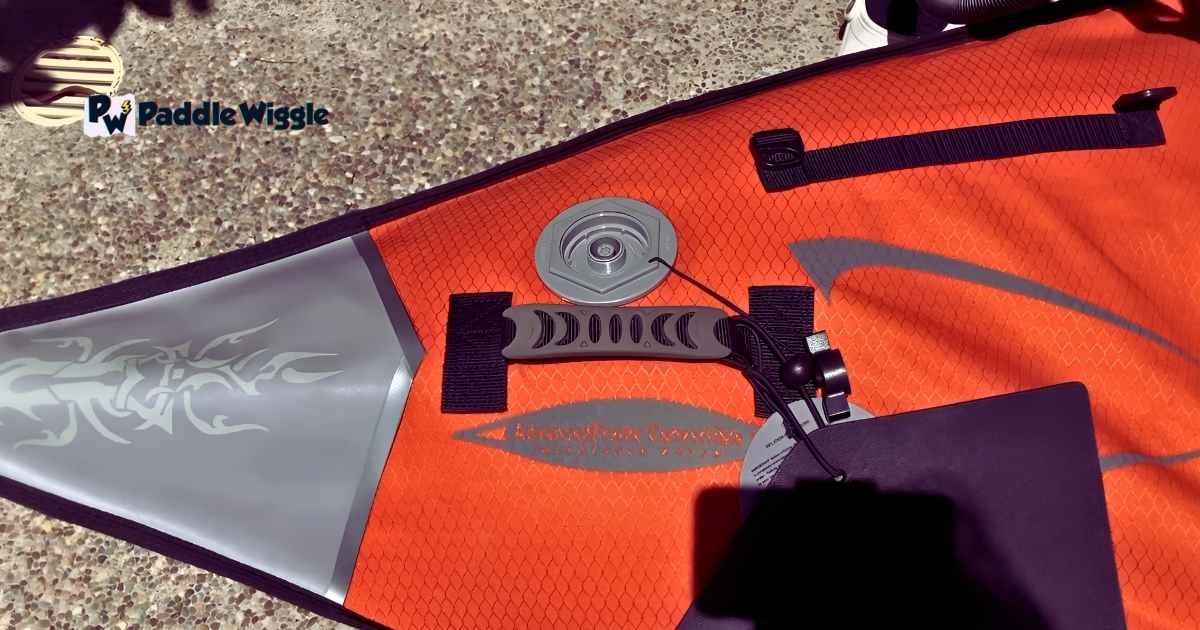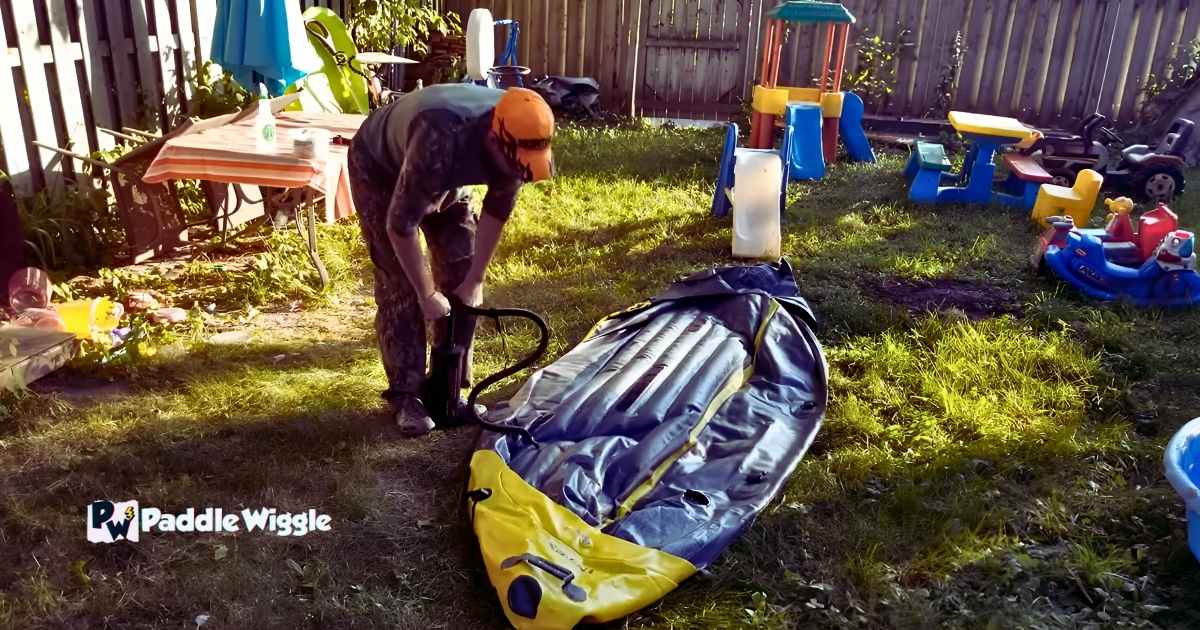Inflatable kayaks are a versatile and convenient watercraft option for outdoor enthusiasts. Despite their benefits, they still spark curiosity, with whispers of doubt surrounding their durability and stability.
So, are inflatable kayaks safe? In short, inflatable kayaks are safe. However, their safety largely depends on using them appropriately in suitable conditions.
Advanced technology and durable materials are used in the design of modern inflatable kayaks, which ensures their stability and safety on the water. In fact, you can even use them to explore the deep ocean!
Check this: Can You Use An Inflatable Kayak In The Ocean?
However, like any kayak, safety largely depends on the paddler’s knowledge, experience, and adherence to safety guidelines.
In this article, we aim to evaluate the safety of inflatable kayaks. Debunking the myths, we’ll unravel the truth behind inflatable kayaks’ safety and shed light on the doubts surrounding them.
Contents

Are inflatable kayaks easy to puncture?
Inflatable kayaks have long been the subject of skepticism. However, it’s time to debunk inflatable kayak safety myths and address concerns regarding punctures and leaks.
So, are inflatable kayaks easy to puncture? No, inflatable kayaks are not flimsy or prone to punctures.
Manufacturers have made significant advancements in materials and construction techniques. Inflatable kayaks are now designed with robust materials such as PVC or Hypalon, making them resistant to tears and punctures.
They often feature multiple air chambers, which provide added stability even if one chamber is compromised.
Yet, no watercraft is entirely immune to damage! But modern inflatable kayaks are built with reinforced bottoms and sides for enhanced protection against sharp objects.
In the unlikely event of a puncture or leak, most models come equipped with repair kits that allow users to fix minor damages themselves quickly.
Tips for avoiding common causes of punctures


While inflatable kayaks are designed to be durable, taking precautions is essential to avoid punctures. So, checking the area around you before you start paddling is a good idea.
Here are a few tips to help you avoid punctures:
Check for any sharp objects before inflating
Before inflating your kayak, carefully inspect where you plan to set it up. Remove any debris or sharp objects that could potentially cause damage.
Avoid dragging your kayak on rough surfaces
Dragging an inflated kayak across rough terrain can increase the risk of punctures. Instead, carry it whenever possible or use a wheeled cart specifically designed for transporting inflatable watercraft.
Keep away from sharp edges and abrasive surfaces
When paddling, steer clear of rocky shorelines or areas with submerged branches that could damage your kayak’s air chambers.
Follow the recommended pressure levels
To make sure you stay safe while paddling an inflatable kayak, follow the recommended pressure levels for actual stability.
And when you’re not using it, store it properly, away from very hot or very cold.
Evaluating the Safety: How Safe Are Inflatable Kayaks
As inflatable kayaks surge in popularity, the question of their safety remains a topic of interest for water enthusiasts. Can inflatable kayaks truly deliver on their promise of adventure without compromising safety?
Let’s evaluate this:
Stability
Inflatable kayaks are designed to stay stable on the water. Their wide bases create a strong and steady foundation, even when the water gets rough, or there are waves. Inside the kayak, there are multiple air chambers that help distribute the air evenly. This means that if one chamber gets damaged, the kayak won’t suddenly deflate, keeping you safe and secure as you paddle in different water conditions.
Balance
Having a good balance is important for a smooth and enjoyable kayaking experience, and inflatable kayaks are great at providing just that. With their low centers of gravity, these kayaks give you a stable and well-balanced ride. This makes it easier to stay in control, whether you’re paddling on calm waters or facing a bit of turbulence.
Maneuverability
Even though they are inflatable, modern inflatable kayaks are designed with special systems that make them easy to maneuver. These systems respond well to your paddle strokes, allowing you to make precise turns and easily change direction.
Whether you’re exploring narrow waterways or trying out tricky routes, inflatable kayaks are an excellent choice for anyone, whether you’re just starting or have lots of experience. They are versatile and easy to handle, allowing you to paddle wherever you want!
Factors Contributing to Overall Safety
When it comes to evaluating the safety of inflatable kayaks, several crucial factors play a significant role.
Let’s delve into these essential elements that contribute to the overall safety of inflatable kayaks:
Material Durability
The construction of inflatable kayaks using high-quality puncture-resistant materials, such as PVC or Hypalon. These are highly durable and significantly enhance their resilience.
These robust materials can withstand encounters with various obstacles in waterways. It reduces the risk of potential damage or deflation during paddling.
Buoyancy
One of the inherent advantages of inflatable kayaks is their buoyancy. The ability to stay afloat even if fully submerged adds an extra layer of safety. It reassures paddlers and prevents potential hazards in emergencies.
Self-Bailing Design
Many inflatable kayak models incorporate a self-bailing system. This feature drains water from the kayak during paddling.
This prevents water accumulation, ensuring the kayak remains stable and responsive. This also reduces the risk of capsizing or instability.
Multiple Air Chambers


Inflatable kayaks are designed with multiple air chambers. It’s a key safety feature that distributes air evenly throughout the vessel.
In case of damage to one chamber, the remaining air chambers maintain buoyancy and stability. This ensures the paddler safely returns to shore.
Reinforced Seams and Construction
Reinforced seams and sturdy construction further bolster the safety of inflatable kayaks. Quality manufacturing ensures that the kayak can handle the stress of paddling and remains reliable in various water conditions.
Debunking The 5 myths related to Inflatable Kayaks Safety
In recent years, inflatable kayaks have gained significant popularity among outdoor enthusiasts. Nevertheless, a few misconceptions have surfaced concerning their safety.
Let’s debunk them:
Myth #1: Inflatable Kayaks Are Less stable
It’s a common misconception that inflatable kayaks lack stability compared to hard-shell kayaks. Modern inflatable kayaks are specially designed to be stable on the water. They have wider bases, which make them feel steady even in wavy or choppy waters.
This stability makes paddling safer and gives you more confidence, especially if you’re new to kayaking.
Today, inflatable kayaks also have multiple air chambers inside them. This means that even if one part gets damaged, the other parts will keep the kayak floating and stable. So, there’s no need to worry about sudden deflation or tipping over.
Inflatable kayaks are not just for calm waters. They are made to handle different water conditions, including moderate rapids or rough rivers. People have tested them in challenging situations, and they’ve proven to be reliable for exciting adventures!
Myth #2: Inflatable Kayaks are Unsafe for Whitewater


In recent years, manufacturers have made special inflatable kayaks, particularly for whitewater paddling.
These kayaks are built with strong materials and extra safety features, making them durable and reliable in rough river waters. They are designed to handle the impact of rocks and obstacles that you might encounter in whitewater environments.
They have multiple layers of tough fabric, like PVC or Hypalon. This makes them strong and resistant to punctures. The seams are also reinforced to prevent tearing and keep the kayak in good shape, even in challenging situations.
Inflatable whitewater kayaks have extra buoyancy and buoyant floors to make them even safer. This helps the kayak stay stable and prevents it from tipping over or getting stuck in rough waters. Some of these kayaks also come with foot braces and adjustable thigh straps, which help paddlers stay in control and stable while going through rapids.
Manufacturers thoroughly test these inflatable whitewater kayaks to ensure they can handle the challenges of river paddling. They meet safety standards, so you can trust that you’re using a secure and enjoyable kayak.
Besides being safe, inflatable whitewater kayaks have other advantages too. They are easy to carry and transport, so you can take them to remote and exciting whitewater locations.
Myth #3: Inflatable Kayaks Can Sink Easily
That’s not the case at all! Inflatable kayaks are made with different air compartments inside. If one part gets a hole, the other compartments will still have air, keeping the kayak floating.
This feature ensures that even if something goes wrong and the kayak gets damaged, you can paddle safely to shore without sinking.
Manufacturers understand how important safety is, so they design them with this extra protection in mind. They know that accidents can happen, but they want to ensure you can have a fun kayaking adventure without any worries.
Just remember to check your inflatable kayak before entering the water, ensuring it’s properly filled with air and in good condition.
But even if you accidentally hit something and get a hole, don’t worry! The other air compartments will keep you afloat and help you get back to safety.
Myth #4: Inflatable Kayaks are Hard to Inflate


Most inflatable kayaks are designed to be easy to inflate and are a simple process.
You can use either a manual pump that you operate with your hands or an electric pump that runs on batteries or electricity. Both types of pumps work well and quickly fill the kayak with air.
The inflation valves on inflatable kayaks are made for convenience. They prevent air from escaping while you’re pumping, so the kayak stays properly filled. These valves are also easy to use so that anyone can inflate the kayak without any special skills.
Inflating the kayak usually only takes a few minutes, depending on its size and the type of pump you use. This means you can get on the water and start paddling in no time!
Myth #5: Inflatable Kayaks are Prone to Popping
Inflatable kayaks are tough and designed to handle different water conditions.
Manufacturers use high-quality materials like PVC or Hypalon to make inflatable kayaks strong. These materials are puncture-resistant. They can handle encounters with rocks and sticks in the water without getting damaged. This protection keeps your kayak safe during your paddling adventures.
Inflatable kayaks are built with strong materials and have multiple layers to make them sturdy. This means they can handle rough waters and obstacles without any problems.
The seams of inflatable kayaks are made extra strong to prevent any weak points that could cause popping or leaking. This careful construction makes sure the kayak stays airtight, even in tough situations.
While no watercraft is completely indestructible, inflatable kayaks are made to give you a safe and fun paddling experience.
Learn More
How Long Do Inflatable Kayaks Typically Last?
Inflatable kayaks typically last 3-5 years. A high-quality inflatable kayak can last longer with proper care and regular inspections.
Also read: How Long Do Kayaks Last?
Are Inflatable Kayaks Suitable For Beginners?
Inflatable kayaks can be great options for beginners due to their stability and ease of use. However, it’s important for beginners to receive proper instruction on paddling techniques before venturing out onto the water.
Can I Take My Inflatable Kayak Into Whitewater Rapids?
While some inflatable kayaks are designed for whitewater use, choosing a model specifically built for such conditions is essential. Always check the manufacturer’s recommendations and ensure you have the necessary skills and experience before attempting whitewater kayaking.
Final Words
Inflatable kayaks offer a safe and enjoyable way to explore the waters. Modern inflatable kayaks are designed with advanced techniques to ensure stability and reliability on the water. Just be aware of your surroundings, and have fun on your own!



